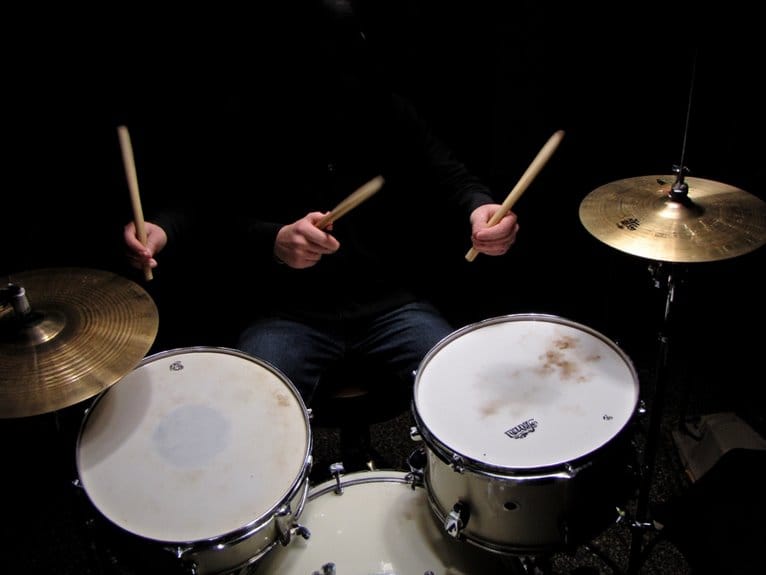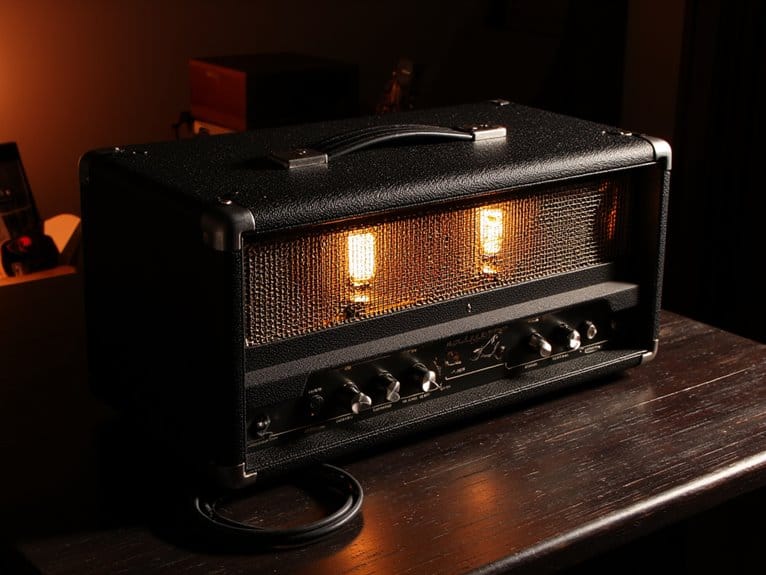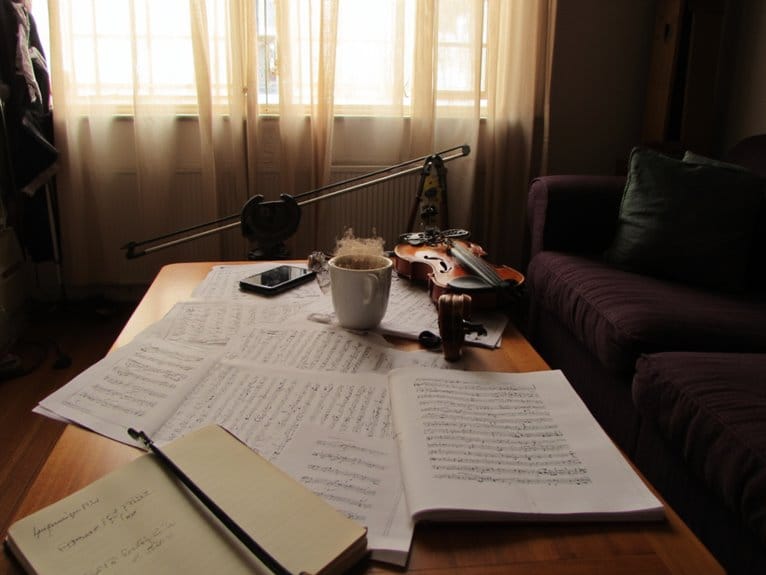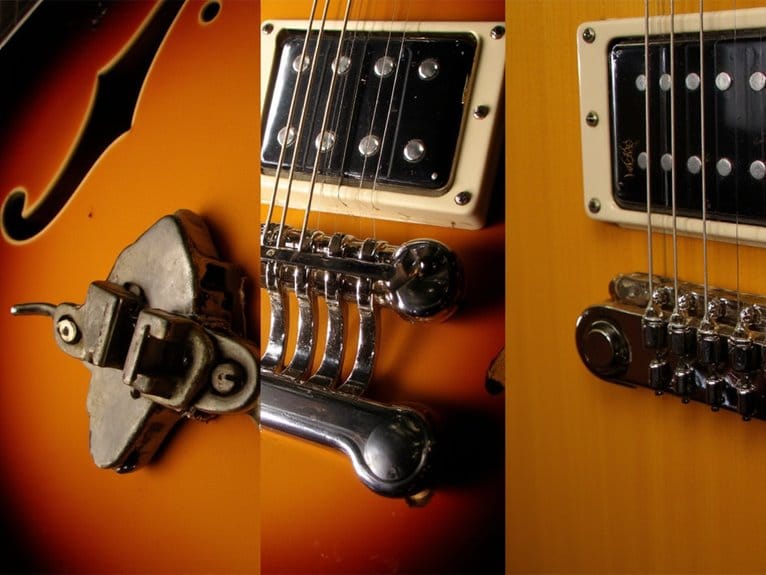Amplifying Acoustic Instruments for Performance
You’ll need directional cardioid microphones and quality DI boxes with proper impedance matching to amplify your acoustic instrument without feedback issues. Strategic stage positioning, away from speakers, combined with preamps featuring notch filters and multi-band EQ, controls that piercing squeal while preserving natural tone. Budget options like the Fishman Platinum Pro EQ work well, though professional setups benefit from higher-end gear like the Grace Alix preamp. Understanding your venue’s acoustics and reverberation characteristics will open up even more sophisticated amplification techniques.
We are supported by our audience. When you purchase through links on our site, we may earn an affiliate commission, at no extra cost for you. Learn more.
Notable Insights
- Use directional cardioid microphones to minimize acoustic feedback between loudspeakers and microphone inputs during live performances.
- Employ proper impedance matching with quality DI boxes and preamps to ensure clear sound transmission without equipment damage.
- Position delicate acoustic instruments strategically in front of louder sections to improve sound separation and projection.
- Manage gain relationships carefully and use notch filters or EQ adjustments to control feedback at problematic frequencies.
- Consider room acoustics and reverberation time when placing instruments and selecting amplification equipment for optimal sound quality.
Understanding Feedback Loops and Acoustic Resonance
Why does that piercing squeal emerge from your amplified acoustic guitar just when you’re hitting your stride during a performance?
You’re experiencing acoustic feedback, which occurs when sound from your loudspeaker re-enters your microphone, creating a reinforcing loop that amplifies specific frequencies.
The feedback characteristics depend on your instrument’s natural resonance, room acoustics, and equipment placement, with certain frequencies experiencing minimal phase shift that enables sustained howling.
I’ve learned that understanding these feedback loops helps you anticipate problematic frequencies before they derail your performance.
Effective resonance control involves managing the gain relationships between your pickup, amplifier, and speaker while considering your guitar’s body resonance and the venue’s acoustic properties, allowing you to harness feedback creatively rather than fight it constantly. Environmental factors like temperature changes can shift these feedback frequencies during your performance, requiring ongoing adjustments to maintain optimal sound quality. Using directional microphones with cardioid patterns can significantly reduce the acoustic path between your audio output and input, minimizing unwanted feedback occurrences. Many guitarists rely on studio-quality headphones for monitoring during practice sessions, but proper impedance matching between headphones and guitar amps ensures optimal sound quality and prevents equipment damage. Professional monitoring headphones with superior sound isolation help musicians hear their acoustic instruments clearly without introducing unwanted ambient noise that could interfere with their performance.
Choosing the Right Equipment for Your Performance Setup
Once you’ve mastered the relationship between feedback and resonance, you’ll quickly discover that your equipment choices can either amplify these challenges or help you control them with precision. Your pickups selection forms the foundation, whether you’re considering piezo, magnetic, or hybrid systems that capture your instrument’s natural voice. Smart preamp features like notch filters, phase switches, and multi-band EQ become essential tools for taming problematic frequencies before they reach your amplifier.
| Equipment Type | Budget Option | Professional Choice |
|---|---|---|
| Preamp/DI | Fishman Platinum Pro EQ ($299) | Grace Alix ($625) |
| All-in-One System | Tech 21 Acoustic Fly Rig ($299) | Audio Sprocket ToneDexter ($399) |
| Microphone | Shure PGA81 | Shure SM81 |
Quality DI boxes guarantee impedance matching, while powered monitors help you hear yourself clearly without chasing feedback issues across different venues. Understanding how volume levels and EQ adjustments affect tone perception in a band mix is critical for achieving optimal sound performance. When incorporating microphones into your setup, proximity effect naturally enhances bass response as you position the mic closer to your instrument.
Optimizing Stage Layout and Room Acoustics
How can strategic positioning transform a problematic acoustic space into one that enhances your performance rather than fighting against it? Through careful stage design and reflective surfaces optimization, you’ll dramatically improve your sound projection and acoustic balance.
I’ve learned that positioning delicate instruments like violins and flutes in front of vocal groups creates better separation, while grouping brass sections together and aiming them toward the audience reduces unwanted spill.
Strategic instrument placement, combined with absorptive materials on back walls and side areas, provides effective echo control without killing the room’s natural liveliness. Effective collaboration between engineers and musical directors ensures that acoustic solutions align with performance goals. By incorporating diffusive surfaces that scatter sound waves evenly, you’ll achieve that sweet spot where every note rings clearly while maintaining the ensemble’s cohesive blend. Understanding your venue’s reverberation time helps determine whether you need more absorption or can embrace the room’s natural acoustics.
On a final note
You’ve got the foundation now-understanding feedback loops, selecting appropriate equipment, and optimizing your acoustic environment. I’ll admit, it’s not rocket science, but getting these elements working together takes practice and patience. Don’t expect perfection on your first attempt; even seasoned performers occasionally deal with unexpected squeals or dead spots. Focus on consistent monitoring of your gain staging, maintain proper microphone placement distances, and you’ll develop the confidence to amplify any acoustic instrument effectively.







